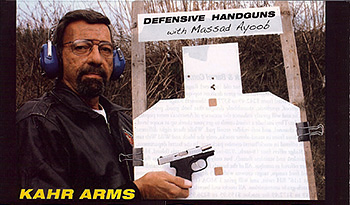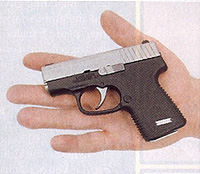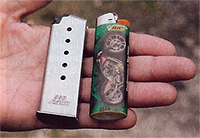- Telephone: 508-795-3919
- Contact Us
- My Account • Dealer Log In
- Technical Support • Service Shipping

KAHR ARMS P380
On Target, February/March 2010, p. 34 - 37
By Massad Ayoob
 The Kahr P380 is the latest entry in the sub-10-ounce .380 sweepstakes, and might just be the vehicle to bet your money on in that particular race.
The Kahr P380 is the latest entry in the sub-10-ounce .380 sweepstakes, and might just be the vehicle to bet your money on in that particular race.
The arrow points to a spent casing as Mas is back on target, firing the P380 weak hand only—a typical backup gun employment.
SUPERCHARGED by the Ruger LCP and the resurgent Kel-Tec P3AT, the market niche of wafer-thin vest pocket size .380s that weigh under ten ounces is one of the hottest in the defensive firearms world. Enter the Kahr P380. With a 15-year record of making high-quality, compact and subcompact pistols in 9mm, .40, and .45 ACP, Kahr Arms has scaled their standard design down further with a micro .380 that carries small and shoots big.
Designer Justin Moon told me proudly that the P380 carries well in a plastic “pocket protector” in a shirt pocket, with a pen next to it for camouflage. I found it to carry well in a pocket holster in the hidden “breast gun pocket” behind the regular pocket of an EOTAC tactical shirt. The 6-round magazine is barely larger than a Bic lighter, and so long as the trigger guard is covered, the pistol is perfectly safe to carry with a seventh round in the chamber, ready to go.
And, more than most everything else in its class, it is easy to shoot well.
Accuracy
MANY TESTS OF “pocket guns” limit accuracy testing to fifteen, ten, or even seven yards on the theory that they’re intended for close range use. Understood. I still want to see what a carry gun will do at 25 yards. That’s the traditional distance for testing pistol accuracy, for one thing, and gives us something of a benchmark for assessment. For another thing, the situation may not cooperate with our preconceptions, and we might have to shoot farther than we thought. A friend and graduate of mine once got into a shootout at 23 yards with an armed robber he didn’t think would engage him from so far away, but did. Fortunately, my friend knew how to shoot a 2-inch J-frame .38 Special revolver at longer range, and dropped the had guy at 23 paces.
So, I took the 10-ounce pistol to the 25-yard bench with three different loads and an MTM pistol rest. I usually fire 5-shot groups and measure, first, all five, and then the best three hits, on the theory that this will usually factor out enough human error that the second measurement will give a good prediction of the gun’s mechanical accuracy. The 5-shot group is a reasonable predictor of what someone can do with a solid shooting platform, some pistol experience . . . and no stress, since there isn’t any of that at the bench. In the case of the Kahr P380, the dual-measurement approach proved to be a good idea, because this pistol—or I—consistently threw one shot wide. Never the first shot (the common “four plus one” syndrome), but always a round in the middle of the string.
Going in alphabetical order, American Eagle 95-grain FMJ had a 5.30-inch group for all five round-nosed bullets. The best three of them were in 3.00”. All measurements were center to center between the farthest holes measured, and to the nearest 0.05”. There are those who recommend ball ammo like this in a .380, on the theory that hollow points with feeble .380 ballistics may lack adequate penetration. Good theory as far as it goes (no pun intended), but we have to remember that it was with round-nose FMJ like this that the .380 earned its reputation as something less than a reliable man stopper.
MagTech’s 95-grain JHP (jacketed hollow point) had a great group going until one shot went astray. That one opened up the 5-shot group to 4.85”. The other four shots were in a much more consistent 2.60”. The best three hits landed 1.15” apart, showing potential for outstanding accuracy given the size and weight of this tiny platform.
Remington 88-grain JHP gave the most consistent pattern of the test. The five shots delivered a 3.20” 25-yard group, and the best three of them were under two inches: 1.95”, to be specific.
For perspective, all of these groups would have been well within the 8-inch Down Zero circle in an International Defensive Pistol Association target, or the 6” x 9” center A-zone of an International Practical Shooting Confederation silhouette. For a gun that most buyers will envision using at bad breath distance anyway, that’s more than acceptable accuracy. It’s also better than most of us have come to expect from small, double-action-only semiautomatic pistols in the feathery sub-ten-ounce weight range.
Shootability
 To give you a perspective of the P380’s diminutive size, its shown here resting in the palm of an average-sized, adult male hand. Its slim profile is equally as impressive.
To give you a perspective of the P380’s diminutive size, its shown here resting in the palm of an average-sized, adult male hand. Its slim profile is equally as impressive.
 Two of the best 25-yard, 5-shot groups fired from the P380
Two of the best 25-yard, 5-shot groups fired from the P380 The P380’s magazine holds considerably more firepower than a Bic lighter, but is very comparable in size.
The P380’s magazine holds considerably more firepower than a Bic lighter, but is very comparable in size. Add the load carried by the magazine to the one in the pipe, and you have a 7-round capacity.
Add the load carried by the magazine to the one in the pipe, and you have a 7-round capacity. Large, serrated controls can be reached easily and operated quickly.
Large, serrated controls can be reached easily and operated quickly.IT IS IN THIS SOMETIMES subjective, sometimes objective area that the P380 seems to shine. A lot of this has to do with the famously smooth trigger pull that is the trademark of the double-action-only, striker-fired Kahr line. On out test gun, it averaged a smooth and consistent. 5 lbs. 11 oz. as per Lyman’s digital trigger-pull gauge from Brownell’s. The stroke was even, with no palpable stacking or increased trigger resistance just before the shot.
The first P380 prototype that I fired in Memphis in the spring of ’08 had a smaller trigger guard. Some testers had found that the front edge of the guard banged their fingers a little when the pistol went off, so production was delayed until Kahr could enlarge the trigger guard on production models. None of our test team, including guys with sausage-like fingers, had any problem with the current P380. The three petite females in the test squad all loved the trigger, and commented on the gun’s soft recoil. (The guys, of course, appreciated the latter as well.)
Good sights are necessary for good shooting, and they are sorely lacking on most mini-.380s. They tend to have tiny, vestigial sights, and one famous model has no sights at all. By contrast, the sights on the Kahr P380 are the exact same bar/dot Von Stavenhagen-pattern found on their bigger guns. You can see them . . . and you can hit with them. The test gun sent to On Target shot a bit to the right with most ammo (everything but the Remington 88-grain JHP, interestingly enough), and in reasonably fast shooting we found it no problem to bit the 6-inch diameter steel plates on my Action Target Dueling Tree, the most fun setup on my personal range. My only disappointment was that the little .380 bullets wouldn’t spin the steel targets all the way around to the other side, like 9mm Luger rounds do. But that’s hardly the gun’s fault.
Another big advantage of this pistol is that, being authentically scaled down from the standard Kahrs, it has a fully operational slide lock lever. The Ruger LCP does not lock back automatically when it’s empty, though it has a tiny lever that you can manipulate upward to hold the slide open for safety-officer inspection at a public range or in a shooting class or match. A couple of the other popular .380s in this size/weight class can’t have their slides locked back at all. The Kahr P380, however, will easily lock open by hand for manual inspection, and will reliably lock open on an empty magazine. When it’s time to reload, it’s easy to thumb down the slide release lever or tug the slide to the rear manually and let go, to chamber the next round. This makes reloading much faster, and arguably even makes the pistol safer to handle, at least for some users.
Reliability
MOST PROFESSIONALS suggest putting at least a couple of hundred rounds through any handgun—particularly a semiautomatic—before you trust it for anything serious. Kahr Arms is honest enough to flatly state this in their literature, and I applaud them for that. In this particular test gun, that turned out to be absolutely necessary.
We did not disassemble and lube the gun before shooting, because everyone was eager to fire it as soon as it came out of the box. Early on, we noticed failures to go into battery, a couple of 12 o’clock misfeeds, and multiple extraction failures. After a hundred-some rounds, the gun was lubed. That reduced the malfunctions, but did not completely eliminate them. We then gave the little beast a good cleaning and relubed it. By then we were right around the 200-round mark.
I dunno if it was the Boresnake, the brushes, the lubricant or the 200-round break-in, but the pistol seemed to have clear sailing thereafter. This is the second time I’ve seen a Kahr jam repeatedly within its first two hundred shots, and then go to l00% reliability, the other one having been a .45. The bottom line is simple: Keep it clean. Kahrs tend to have tight chambers, so keep it lubricated. And definitely do the 200 round break-in, then put a couple hundred of your carry loads through it just to be sure. This is a wise practice with any carry gun, and proved to be essential with our test-sample P380.
Small Gun — Big Picture
I’VE PERSONALLY RUN across too many cases of slow stops and non-stops with .380 hits to trust that caliber for self-defense. At the same time, this new generation of super-thin, super-light, super-small .380s is going to put guns on the persons of some who otherwise wouldn’t carry. I know an MD who carries a Seecamp in a belly-band under his scrubs because he’s convinced nothing larger will conceal, and under hospital rules he’ll be fired if he’s found to be armed. I know two professional women who carry P3AT Kel-Tecs at work in their pants pockets, and simply wouldn’t be armed if their only choices were larger handguns. I know a woman who didn’t used to carry backup, but discovered that an LCP worked perfectly for her as an everyday second gun. This is the niche market that the Kahr P380 was intended to fit.
This whole category of .380s can be finicky in feeding. Kel-Tec had to develop a “fluff and buff” tune-up to get some P3AT specimens to run reliably. Ruger has had to call back LCPs. Our test Kahr P380 truly needed the factory-recommended 200-round break-in.
The LCP from Ruger and the P3AT from Kel-Tec carry suggested retails of around $325-$330, and the Kahr P380 with its matte stainless-steel slide is roughly twice the price at $650 MSRP. And unlike anything else in its weight class, it’s also available with night sights ($758). At twice the money, is it twice the gun?
Let’s say it’s twice as shootable. With its totally functional, easy working slide-stop/ slide-lock lever, it’s much faster to reload. The sights are more than twice as good, and the trigger pull is a lot more workable, particularly in fast shooting. If I was in the market for an under-one-inch-thin, under-ten-ounce .380, there’s no question that I’d buy the one I could shoot best, due to the .380 round’s inherent lack of power. For me, that would be the Kahr P380, hands down.
See the new P380 at your nearest dealer, or for more details contact Kahr Arms, Dept. OT; Tel.: (508) 795-3919; Fax: (508) 795-7046; Web: www.kahr.com
<< Go back to Previous Page
